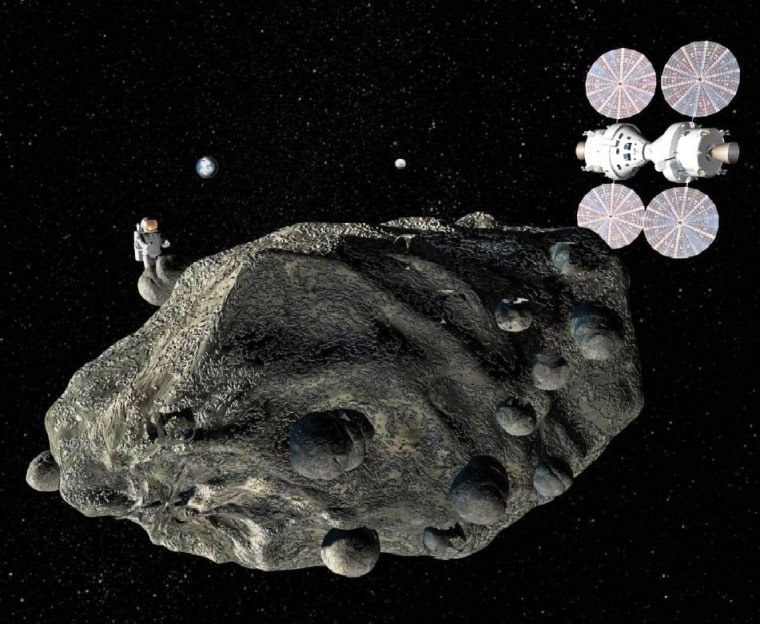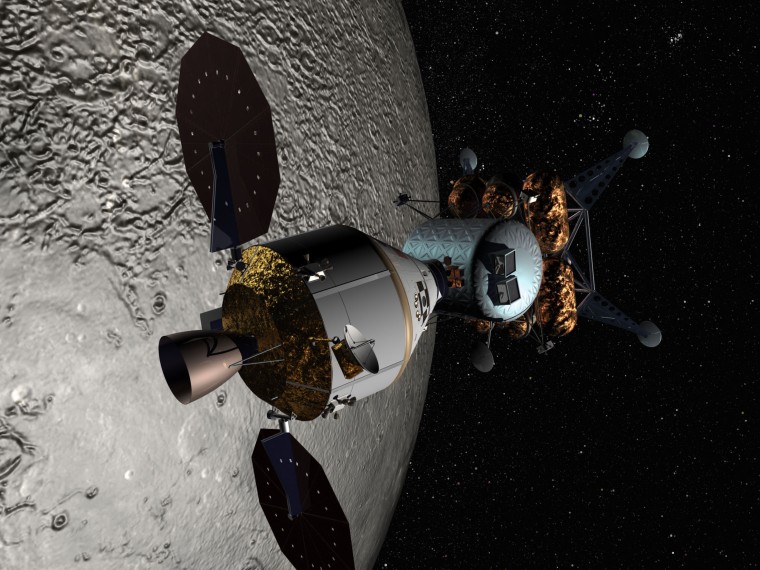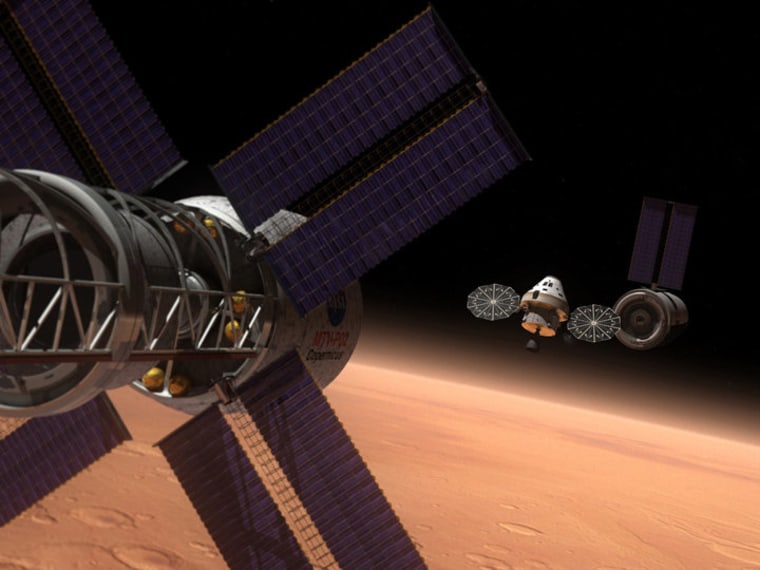
To the moon? Or to an asteroid? Both destinations have been in NASA's sights — the moon during the George W. Bush administration, and a near-Earth asteroid during the Obama administration. Now a "Global Exploration Roadmap" being drawn up by NASA and its counterparts around the world lays out a 25-year scenario for each of the two paths leading beyond Earth orbit.
Both of the paths are aimed at the same eventual destination: Mars. And some observers are suggesting the best course is to aim directly at the Red Planet, rather than starting with closer destinations.
The moon vs. asteroid debate was brought back into the spotlight during the deliberations of a panel known as the International Space Exploration Coordination Group, or ISECG. The group, which includes representatives from Britain, Canada, the European Space Agency, France, Germany, Italy, Japan, Russia, South Korea and the United States, was established as a coordination forum for space exploration back when NASA was aiming for a return to the moon by 2020.
Over the past year, the group has retooled the long-term global strategy for space exploration. "It begins with the International Space Station and expands human presence throughout the solar system, leading ultimately to human missions to explore the surface of Mars," NASA said today in a news release. "The roadmap flows from this strategy and identifies two potential pathways: 'Asteroid Next' and 'Moon Next.'"
NASA said "each pathway represents a mission scenario over a 25-year period describing a logical sequence of robotic and human missions." That scenario would be consistent with the plan that President Barack Obama laid out two years ago, with a goal of sending astronauts to a near-Earth asteroid by 2025 and pushing out to Mars and its moons by the mid-2030s. The new twist is that the moon is back on the table as the initial destination beyond Earth orbit.

Senior space officials gave their go-ahead to the two-pathway plan today during a meeting in Kyoto, Japan, NASA said.
"NASA is confident that the release of this product, and subsequent refinements as circumstances within each space agency evolve, will facilitate the ability of space agencies to form the partnerships that will ensure robust and sustainable human exploration," said Bill Gerstenmaier, NASA's associate administrator for human exploration and operations.
Gerstenmaier is the outgoing chair of the ISECG. The incoming chairman, Yoshiyuki Hasagawa of the Japan Aerospace Exploration Agency, said the group's members were "very happy with the progress of the Global Exploration Roadmap."
NASA spokesman Michael Braukus told me that the roadmap was not yet available for public release, but space officials agreed that an initial version of the document would be issued sometime in the next few weeks. Based on viewgraphpresentations prepared in advance of this week's meeting in Kyoto, both paths would eventually get to the moon as well as asteroids. It's more a question of which destination is targeted first.
One suggested strategy would start by sending a deep-space habitat to an Earth-moon gravitational balance point known as L-1. Later missions would go to the moon, as preparation for eventual Mars trips. Another scenario calls for reaching the lunar surface first. The lessons learned there would be applied to asteroid missions, and then to Mars-bound missions. A variant would focus on testing the deep-space habitat, then taking trips to the moon, then going to an asteroid, and finally flying to Mars. It's not yet clear how all these possibilities are wrapped up into the ISECG's "Asteroid Next" and "Moon Next" scenarios.

Are these 25-year plans necessary, or is it possible to send humans to Mars on a shorter, more direct timetable? SpaceX's millionaire founder, Elon Musk, says a 10-year plan could suffice for a mission to Mars. Rocket scientist Robert Zubrin, president of the Mars Society, made a similar case for an early Red Planet rendezvous last week in a Washington Times commentary:
"We’re ready. Despite its greater distance, we are much better prepared today to send humans to Mars than we were to send men to the moon in 1961, when President Kennedy started the Apollo program - and we were there eight years later. Contrary to those seeking indefinite delay of any commitment, future-fantasy spaceships are not needed to send humans to Mars. The primary real requirement is a heavy-lift booster with a capability similar to that of the Saturn V launch vehicle employed in the 1960s. This is something we fully understand how to create.
"The issue is not money. The issue is leadership. NASA’s average Apollo-era (1961-73) budget, adjusted for inflation, was about $19 billion a year in today’s dollars, just 5 percent more than the agency’s current budget. Yet the NASA of the '60s accomplished 100 times more because it had a mission with a deadline and was forced to develop an efficient plan to achieve that mission. If NASA were given that kind of direction, we could have humans on Mars within a decade. If not, as the rudderless agency continues to drift into the coming fiscal tsunami, we may soon end up with no human spaceflight program."
Gearing up for missions to Mars would likely require a significant boost in space spending, as well as more serious efforts to solve the problems of interplanetary spaceflight, including radiation exposure and zero-G health hazards. The ISECG's deliberations are a sign that deep-space exploration is too expensive for any one country to take on by itself. But the latest reports about the roadmap suggest that the path beyond Earth orbit is not yet set in stone — which means there's still ample opportunity for you to weigh in on the debate.
Click your choice in the poll at right, and feel free to weigh in at length in the comment space below.
In related developments:
- Caltech's Keck Institute of Space Studies has invited students from around the world to participate in a competition to design a mission that would send astronauts to a near-Earth asteroid and return a sample. The team exercise will bring at least 30 students to Caltech from Sept. 12 to 16. The Caltech Space Challenge was created by two Caltech students, Prakhar Mehrotra and Jon Mihaly. "We have more than 275 applications from exceptional students at 100 universities worldwide, including all the top-rated schools," Mehrotra said in a Caltech news release. "Selecting is going to be very hard."
- China's Chang'e 2 spacecraft has left lunar orbit and traveled about a million miles (1.5 million kilometers) from Earth to settle into orbit around the sun-Earth gravitational balance point known as L-2. Chang'e 2's new location was announced today by China's State Administration of Science, Technology and Industry for National Defense. China's Xinhua news agency said Chang'e 2, which spent about eight months orbiting the moon, will carry out exploration activities around L-2 during the coming year. L-2 already serves as the locale for the European Space Agency's Herschel space telescope and NASA's Wilkinson Microwave Anisotropy Probe. It's also the intended destination for the James Webb Space Telescope, which is currently under construction and due for launch around 2018.
- Instead of sending astronauts to an asteroid, how about bringing the asteroid to us? In the journal Research in Astronomy and Astrophysics, scientists at Tsinghua University in Beijing say "it is possible" to nudge an asteroid into temporary Earth orbit, and they provide a list of near-Earth asteroids that just might serve. One possibility is the 10-meter-wide (33-foot-wide) asteroid 2008 EA9, which could be placed in an orbit about twice as far away as the moon for study or for mining over the course of a few years. "Interesting idea," Technology Review's arXiv blog notes. "What could possibly go wrong?"
More about deep-space exploration:
- Gallery: Seven out-of-this-world destinations
- Europe and Russia take aim at Mars
- Counting down to a mission to Mars
- NASA retools spaceship for deep space
Connect with the Cosmic Log community by "liking" the log's Facebook page, following @b0yle on Twitter or adding me to your Google+ circle. You can also check out "The Case for Pluto," my book about the controversial dwarf planet and the search for other worlds.